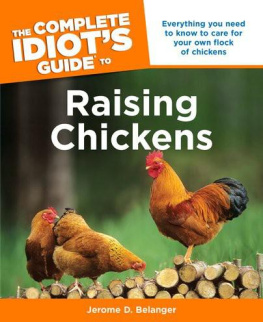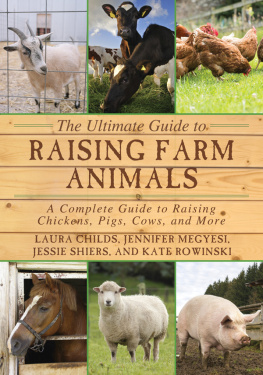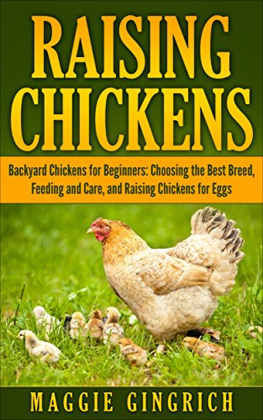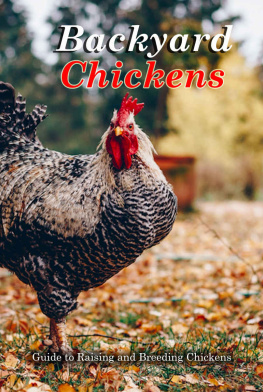Appendix A
Glossary
ABA American Bantam Association.
alektorophobia Fear of chickens.
AMBC American Minor Breeds Conservancy. An organization devoted to saving endangered breeds of domestic livestock, including chickens.
American Standard of Perfection The handbook of the American Poultry Association describing and picturing the ideal characteristics against which each recognized breed is judged.
APA American Poultry Association.
avian Pertaining to birds (Class Aves).
bantam A smaller version of a large chicken, to the size; a small chicken with no large counterpart.
barnyard chicken A chicken of mixed or uncertain parentage.
bedding Litter; any material used to absorb liquids in manure (straw, wood shavings, shredded paper, ground corncobs, etc.).
biddy Old hen (slang).
biosecurity Measures taken to prevent disease.
bloom The final protective coating on an eggshell, which is removed when eggs are washed.
breed (Noun) An established group with similar characteristics that, when mated together, produce offspring with the same characteristics. (Verb) To mate, for reproduction.
breeder A person who breeds chickens; a chicken used for reproduction rather than meat or eggs for food.
broiler A young chicken weighing about 4 pounds; fryer.
brood (Verb) Provide care for chicks. (Noun) A batch of chicks.
brooder A box or other enclosure where chicks are protected and cared for.
broody Used to describe a hen that wants to sit on eggs.
buff A medium shade of orange-yellow with a rich golden cast.
candle To examine the contents of an intact egg with the use of a light.
cannibalism The act of chickens pecking at and eating each other or eggs.
capon A castrated rooster, creating a large and tender roasting fowl.
carrier An individual that shows no symptoms of a disease but can transmit the disease to others.
clean-legged Having featherless shanks (lower part of the leg).
cloaca The terminal region of the gut, into which empty the intestinal, urinary, and genital canals.
clutch A setting or group of eggs for hatching.
coccidiosis An intestinal disease caused by a parasitic sporozoan.
coccidiostat A drug that prevents or treats coccidiosis; the specific drug and dosage vary with intent and the coccidia species involved.
cock A male chicken; rooster.
cockerel A male chicken under one year old.
comb The fleshy red-to-purple (depending on breed) growth on top of a chickens head, seen in various shapes and forms (also depending on breed), but larger in the rooster of any given breed.
compost (Noun) A mixture of decayed organic matter used to enrich soil. (Verb) To mix organic materials together in such a way as to achieve controlled decomposition.
conformation The general shape and structure of a body.
coop Chicken house.
crop A sac (an enlarged part of the gullet), located on a birds chest, in which food is temporarily stored immediately after its eaten.
crossbreed (Verb) To mate two birds of different breeds. (Noun) The offspring of such a mating.
cull (Verb) To eliminate an undesirable individual from the flock based on productivity, a standard of perfection, health, etc. (Noun) The bird itself.
debeak To cut off a portion of the upper beak to prevent cannibalism.
diatomaceous earth (DE) A light, porous sedimentary rock composed of the shells of diatoms, used to control insects and other pests.
down Very fluffy short feathers.
droppings Manure.
dust bath Refers to the chickens habit of rolling in dust or dry soil to control mites and lice and to remove excess oil from the feathers.
ear lobes Fleshy patches of bare skin below the ears, varying in size and shape according to breed.
egg tooth A horny growth on a chicks upper beak, used to break through the eggshell at hatching time.
embryo A fertilized ovum; a chick before its hatched.
encephalomalacia Softening of the brain.
excreta Waste matter eliminated; bird manure consisting of both feces and uric acid.
exhibition breeds Chickens bred and kept for appearance rather than egg or meat production, usually to be displayed at competitive poultry shows.
feather-legged Having feathers growing on the shanks (lower part of the leg).
fecal Having to do with solid bodily waste.
feces Solid bodily waste.
fertile (Egg) One containing a live embryo. (Chicken) One capable of reproducing.
flock Any number of chickens living together as a group.
forage (Verb) To scavenge for food on free-range. (Noun) Food found by scavenging.
fowl Any domestic bird; poultry.
free-range Refers to chickens allowed to roam at will.
fryer A tender young chicken weighing about 4 pounds; broiler.
gizzard A very strong muscular organ that, with the aid of grit, grinds up a birds food for further digestion.
grit Small stones or other hard materials a bird ingests to help grind food in the gizzard.
hackles The feathers on the rear and sides of the neck; usually different in shape and structure according to sex.
hatch (Verb) To emerge from an egg. (Noun) A group of chicks that emerge from their eggs at roughly the same time.
hen A female chicken more than one year old.
hybrid Any bird or animal with parents of two different breeds.
immunity Resistance to a particular disease, often as the result of an inoculation.
incubate To hatch fertile eggs.
incubation period Time required for an egg to hatch; for chickens, normally 21 days.
incubator A heated machine for hatching eggs.
keel Breastbone.
litter Bedding; straw, ground corncobs, wood shavings, or similar absorbent materials on the floor of a coop.
mate To breed; to engage in sex.
Mareks Disease A widespread, highly contagious virus disease of chickens, commonly controlled by vaccination upon hatching.
milo Grain sorghum.
mite A tiny bothersome parasite.
molt (Verb) To lose old feathers and grow new ones. (Noun) The process or time during which feathers are shed.
nest A place where a chicken lays eggs.
nest egg An artificial egg, usually made of wood or plastic (but sometimes just a golf ball), used to encourage hens to lay eggs in a certain place.
nestbox A box or similar enclosure provided as a secure place for a chicken to lay eggs.
oocysts The eggs of certain parasites.
parasite An organism that lives in or on another organism offering no benefit to the host.
pasting The result of loose droppings that stick to the body and feathers in the vent area; also known as pasty bottom.






